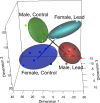Sex-Dependent Effects of Developmental Lead Exposure on the Brain
- PMID: 29662502
- PMCID: PMC5890196
- DOI: 10.3389/fgene.2018.00089
Sex-Dependent Effects of Developmental Lead Exposure on the Brain
Abstract
The role of sex as an effect modifier of developmental lead (Pb) exposure has until recently received little attention. Lead exposure in early life can affect brain development with persisting influences on cognitive and behavioral functioning, as well as, elevated risks for developing a variety of diseases and disorders in later life. Although both sexes are affected by Pb exposure, the incidence, manifestation, and severity of outcomes appears to differ in males and females. Results from epidemiologic and animal studies indicate significant effect modification by sex, however, the results are not consistent across studies. Unfortunately, only a limited number of human epidemiological studies have included both sexes in independent outcome analyses limiting our ability to draw definitive conclusions regarding sex-differentiated outcomes. Additionally, due to various methodological differences across studies, there is still not a good mechanistic understanding of the molecular effects of lead on the brain and the factors that influence differential responses to Pb based on sex. In this review, focused on prenatal and postnatal Pb exposures in humans and animal models, we discuss current literature supporting sex differences in outcomes in response to Pb exposure and explore some of the ideas regarding potential molecular mechanisms that may contribute to sex-related differences in outcomes from developmental Pb exposure. The sex-dependent variability in outcomes from developmental Pb exposure may arise from a combination of complex factors, including, but not limited to, intrinsic sex-specific molecular/genetic mechanisms and external risk factors including sex-specific responses to environmental stressors which may act through shared epigenetic pathways to influence the genome and behavioral output.
Keywords: brain; developmental exposure; epigenetics; gene; lead; neurotoxicity; prenatal stress; sex.
Figures


Similar articles
-
Effects of developmental lead exposure on the hippocampal methylome: Influences of sex and timing and level of exposure.Toxicol Lett. 2018 Jun 15;290:63-72. doi: 10.1016/j.toxlet.2018.03.021. Epub 2018 Mar 20. Toxicol Lett. 2018. PMID: 29571894 Free PMC article.
-
Developmental Lead Exposure and Prenatal Stress Result in Sex-Specific Reprograming of Adult Stress Physiology and Epigenetic Profiles in Brain.Toxicol Sci. 2018 Jun 1;163(2):478-489. doi: 10.1093/toxsci/kfy046. Toxicol Sci. 2018. PMID: 29481626 Free PMC article.
-
Lineage- and Sex-Dependent Behavioral and Biochemical Transgenerational Consequences of Developmental Exposure to Lead, Prenatal Stress, and Combined Lead and Prenatal Stress in Mice.Environ Health Perspect. 2020 Feb;128(2):27001. doi: 10.1289/EHP4977. Epub 2020 Feb 5. Environ Health Perspect. 2020. PMID: 32073883 Free PMC article.
-
Zebrafish as a model for investigating developmental lead (Pb) neurotoxicity as a risk factor in adult neurodegenerative disease: a mini-review.Neurotoxicology. 2014 Jul;43:57-64. doi: 10.1016/j.neuro.2014.03.008. Epub 2014 Mar 31. Neurotoxicology. 2014. PMID: 24698670 Review.
-
Animal Models of Childhood Exposure to Lead or Manganese: Evidence for Impaired Attention, Impulse Control, and Affect Regulation and Assessment of Potential Therapies.Neurotherapeutics. 2023 Jan;20(1):3-21. doi: 10.1007/s13311-023-01345-9. Epub 2023 Feb 28. Neurotherapeutics. 2023. PMID: 36853434 Free PMC article. Review.
Cited by
-
Prenatal exposure to metals and autism spectrum disorder: Current status and future directions.Curr Opin Toxicol. 2021 Jun;26:39-48. doi: 10.1016/j.cotox.2021.04.001. Epub 2021 Apr 18. Curr Opin Toxicol. 2021. PMID: 39119269 Free PMC article.
-
Sex difference of pre- and post-natal exposure to six developmental neurotoxicants on intellectual abilities: a systematic review and meta-analysis of human studies.Environ Health. 2023 Nov 17;22(1):80. doi: 10.1186/s12940-023-01029-z. Environ Health. 2023. PMID: 37978510 Free PMC article.
-
Prenatal Lead Exposure, Genetic Factors, and Cognitive Developmental Delay.JAMA Netw Open. 2023 Oct 2;6(10):e2339108. doi: 10.1001/jamanetworkopen.2023.39108. JAMA Netw Open. 2023. PMID: 37870833 Free PMC article.
-
Gender Specific Differences in Disease Susceptibility: The Role of Epigenetics.Biomedicines. 2021 Jun 8;9(6):652. doi: 10.3390/biomedicines9060652. Biomedicines. 2021. PMID: 34200989 Free PMC article. Review.
-
Associations between a metal mixture and infant negative affectivity: Effect modification by prenatal cortisol and infant sex.Child Dev. 2024 Jan-Feb;95(1):e47-e59. doi: 10.1111/cdev.13997. Epub 2023 Aug 23. Child Dev. 2024. PMID: 37610319 Free PMC article.
References
-
- ACCLPP (2012). CDC Response to Advisory Committee on Childhood Lead Poisoning Prevention Recommendations in “Low Level Lead Exposure Harms Children: A Renewed Call of Primary Prevention”. Atlanta: Centers for Disease Control and Prevention.
-
- Ajarem J. S., Abu-Taweel Q. M., Ahmad M. (2003). Effect of postnatal lead exposure on the development and behavior of mice offspring. Saudi. J. Biol. Sci. 10 12–24.
Publication types
Grants and funding
LinkOut - more resources
Full Text Sources
Other Literature Sources

